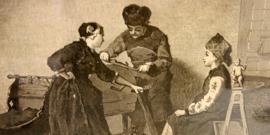As time went on, the sharpening process fell into the domain of shoemakers, blacksmiths and knife sharpeners who began to use motorized vertical grinding wheels to sharpen skate blades. Discoveries about the process were made over time…one of which was that the smaller the vertical grinding wheel’s diameter (producing a larger ROH – radius of hollow), the sharper the edges of the blade became. This led to the realization that a deeper hollow (smaller radius) gave the skater greater mobility (bite) and that a shallower hollow (larger radius) increased speed (glide).

After years of using a vertical wheel it was discovered that a radius could be scribed in the face of the grinding wheel by placing the wheel horizontally and then rotating a single point diamond dresser across the front of the wheel. This innovation not only provided many variations of the radius, but also a radius on the face of the wheel that could be produced and reproduced easily by any operator.

The latest innovation in the process of sharpening skates is the patented ‘Spinner System’. This system uses the horizontal grinding wheel, but dresses the wheel with a ‘spinner’ instead of a single point diamond. A spinner is a disc with a radius machined on its exterior and which is then coated with diamonds. The diamond coated dressing wheel spins and, as it bumps against the face of the grinding wheel, dresses the grinding wheel with a precise radius. The spinner dressing system produces a more accurate dressing result with less effort than was previously required with a single point diamond.

The innovation of the Blackstone patented ‘Spinner System’ is that the operator has the opportunity to put any radius and, most notably, any ‘shape’ on the blade.
Traditionally, skates have been sharpened with a circular (arc) form on the bottom of the blade. This arc (hollow) is a piece of the circumference of a circle and can vary in depth. As the depth of the hollow changes, so does the bite of the blade’s edge. As the hollow gets deeper (with a smaller circle more of its circumference is on the blade), the edges become sharper and more pronounced. Typically this results in the skater being able to cut sharper and be more agile, but speed requires more effort. As the hollow gets shallower (with a larger circle less of its circumference is on the blade), the edges become less pronounced and the blade appears flatter. Typically this results in the skater being able to skate faster, but cutting takes more effort. (The sharper the edge, the more the blade will sink in the ice. Less edge creates more glide due to the fact that more of the blade is on the surface of the ice). Picture the difference between a quarter and a dime - the dime would produce a much deeper hollow because the blade covers more of its circumference compared to the quarter, which would produce a shallower hollow.
It is important to know what hollow you are skating on because it affects your skating technique and how your blade reacts with the ice. Also, knowing your radius/hollow will allow you to get the same sharpening you normally receive even if you travel to a different pro shop.

